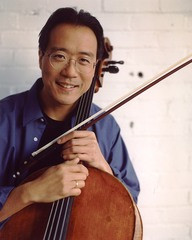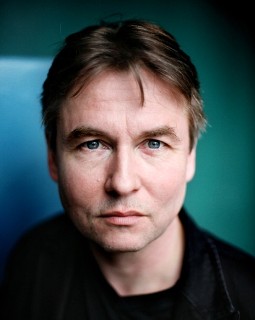|
Back
Incandescence From Two Masters New York
David Geffen Hall, Lincoln Center
03/15/2017 - & March 16, 17, 18, 2017
John Adams: The Chairman Dances
Esa-Pekka Salonen: Cello Concerto (New York Premiere)
Hector Berlioz: Symphonie fantastique (Episode from the Life of an Artist), Opus 14
Yo-Yo Ma (Cellist)
New York Philharmonic Orchestra, Alan Gilbert (Music Director/Conductor)

Y.-Y. Ma (© Alchetron)
With his usual sense of invention and innovation, Maestro Alan Gilbert last night gave his now acclimatized audience three pieces of contemporary music. John Adams (in honor of his seven decades on this earth), Esa-Pekka Salonen (the Marie-Josée Kravis Composer-in-Residence) and a young fella named Hector Berlioz (whose calendar dates are deceptive, for he is the eternal iconoclast).
Actually, the Berlioz mad/opium-hallucinating Symphonie fantastique was played here less than two weeks ago, with a Scheherazade-style story-telling performance by the Boston Symphony Orchestra. Maestro Gilbert didn’t present those suspenseful pauses, the retardations that made us think, “And what happens next, Uncle Alan?”. Instead, this was a five-movement dream. Mr. Gilbert allowed First Oboist Liang Wang to actually lead that opening movement. Mr. Gilbert conducted even more wind-dreams in the third movement (after a quite proper ballroom dance). And of course the last pages are filled with the kind of nightmares which Richard Strauss could barely conceive in Till Eulenspiegel.
(And, forgive the pun, Berlioz executed his terrorizing finale to a Strauss head-chopping which would have been scorned by ISIS).
After the two works by John Adams played by the Phil last week, the opening The Chairman Dances was a retro disappointment. Written before Nixon in China (to me, his finest opera, thanks to Alice Goodman’s piercing libretto), this is a minimalist set of dances with varying rhythms and the usual harmonies which, like an optical illusion, appeared and disappeared before we knew it.
Thirty years ago, The Chairman Dances was highlight of the Adams/Reich/Glass era, but today it sounds clever, funky and–unlike the Berlioz–rather dated.

E.-P. Salonen (© Katja Tähjä)
Now the great moment. And great it was! A major work by Esa-Pekka Salonen. Economics being what it, we don’t have an Archduke or Archbishop commissioning the Cello Concerto. It was commissioned by the Chicago Symphony, NY Phil, Barbican Center London and Elbphilharmonie, Hamburg. And I have no doubt they were thrilled not only to get Mr. Salonen, but the soloist for whom he wrote it, Yo-Yo Ma.
It was evident during the fascinating 30 minutes that every measure took in the Yo-Yo Ma cello persona. Amidst the deep orchestral atmospheres in all three movements, that ineffable Ma sounds was clear and always clean. Mr. Salonen composed some beautiful long romantic lines him to play. Those almost unheard nuances of his cello came out of the twittering, forest-glade orchestra, and one could hear and feel the elements. As for the Yo-Yo Ma technique, that was executed with constant lighting flashes in the third-movement cadenza.
Actually the entire piece is a cadenza, but here the soloist was whizzing over all four strings, sliding down the fingerboard, flashing out all the stops (literally!). And this against Mr. Salonen’s eccentric duet with congas and bongo drums, and a momentary South American rhythm.
Whew!! Yo-Yo Ma never takes the easy way out. He played as if to the Concerto born. And Esa-Pekka Salonen composed as if he were (in Shakespeare’s words) "the onlie begetter”.
And how was the Cello Concerto as a whole? Mr. Salonen is never anything less than fascinating, and one is always amazed at the composer’s control and imagination. The first movement background, with its vibraphone and twittering winds and violins in seeming harmonics, was brilliant, but could almost have been an update to Ravel Daphnis. Atmospherics galore, a cello rising out of the whirlwind. Beautiful stuff altogether.
The second movement was equally verdant in the background, and the soloist’s quarter-tone melodies were luscious, darting in out of the forest noises. It was reminiscent of the late Einojuhani Rautavaara’s Bird Concerto, and later I realized that Salonen had been one of the great Finn’s students.
These two movements were gorgeous, evocative, picturesque. The last movement was pure dynamism. The conga and bongo drums, the changes in tempo, the orchestra prancing through its movements, the oomph, the pizazz, the joy, the piercing high B flat from the cello at the end...
Well, this was another gift from Esa-Pekka Salonen to the orchestra. Wondrous to hear, always surprising, eccentric, a treasure for the New York Philharmonic audiences. Yet was this sufficient? In today’s social and political horrors, a work of such glittering jewels should satisfy every sense. And indeed, the audience roars of approval (including this writer) were well deserved.
Perhaps, then, asking for the soul, the mysteries beneath this great and dense surface is inappropriate. To quote from another Elizabethan poet, “It shall suffice that these notes were born and died for our delight.”
Harry Rolnick
|